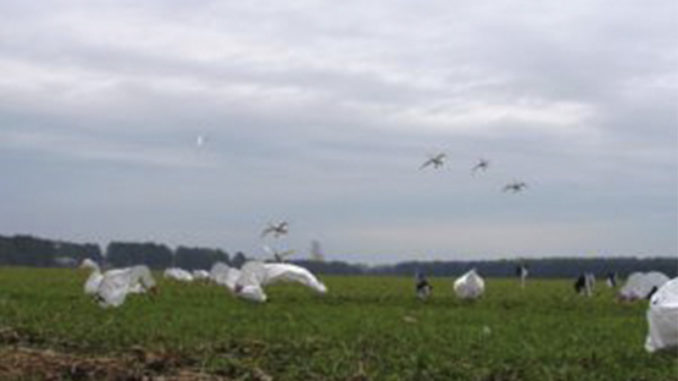
The urge to look up was overwhelming, especially for the youngsters crouched in the small drainage ditch separating two wheat fields near Pungo Lake and the Pocosin Lakes Wildlife Refuge in Washington County. The whistling honk of tundra swans filled the air as flocks of the large, white birds circled the area deciding which field looked better for breakfast.
Peering out from under the corner of his hat to track their flight, Karl Helmkamp of Albemarle Outfitters called to the circling swans by mouth. A 4-time state duck calling champion, Helmkamp apparently had the right message, and a flock of about 20 swans broke out of the circle, turned into the wind and began a long glide towards the decoys and waiting hunters. About 80 yards out, they stalled for a few seconds as if they had seen something they didn’t like, but another call from Helmkamp restored their confidence, and they resumed their glide toward the decoys.
As the birds slowly crept into shotgun range, they were wary, riding into the wind and barely moving forward, scanning the field for something out of place. When they were over the center of the decoys, Helmkamp gave the command to “Take them!” and hunters rose from the banks of the ditch and shouldered their shotguns. The din created by the calling swans was interrupted by the bark of shotguns.
The swans clawed for altitude, but it was too late and they were too slow. Two folded in mid-air and plummeted to the ground below with audible thuds and impacts that could be felt. Swans are the largest waterfowl that visit North Carolina, and the hunters had concentrated on picking some of the larger birds in the flock.
Earlier, Helmkamp, Kathy Dornblazer and Charles Haywood had set up approximately eight dozen snow goose decoys to help lure the swans, and possibly some snow geese, into the field. When the seven hunters arrived — three adults and four of their kids — some took positions along the ditch bank in the middle of the decoys, and Dornblazer led several of the youngsters to another location several hundred yards away at the edge of the field. Here, the younger kids would be close enough to watch and hear, but out of sight of any waterfowl and not sitting with their feet in cold water.
“We have field, impoundment and open-water locations from Currituck Sound to around Mattamuskeet and Pungo refuges to hunt,” Helmkamp said. “We move several times a week to put hunters in concentrations of birds and to keep from overshooting an area. Many of those spots have nice blinds, but there have been so many swans using here during the past week, I thought we could come in and hide on the ditch banks and hunt without needing a blind. Even if it’s a little more difficult, I wanted these kids to see some swans up pretty close.”
Helmkamp was correct. While swans are far more wary than when the permit-only seasons opened more than 30 years ago, they descend on northeast North Carolina in such numbers that the competition for food regularly drives them into shotgun range. Swans do much more harm to a crop like winter wheat than Canada geese, and that was the impetus for opening up hunting. If a farmer has swans or snow geese using a field, he is very likely to give someone permission to hunt — snow geese being even more destructive to crops than swans.
As Helmkamp returned with the downed swans, another group banked on the wind and turned towards the field. Helmkamp stopped and dropped down in the field. Already wearing a white jacket, he pulled a nearby shell decoy over to cover his legs. When he began calling, the swans glided into range, and after two more shots, another bird fell.
“Y’all are doing great staying still,” Helmkamp said. “I didn’t know if you young fellows could stay still long enough, but you have. These swans wouldn’t come in like this if you were moving around. The way they are flying, we should have the next one real soon, and we’ll go get warm.”
Before the morning was over, two flocks of snow geese spied the decoys and began making their way toward the field. They moved much slower and more deliberately than the swans and really looked everything over closely. Finally, at about 70 yards, they hung up and wouldn’t come any closer. After holding almost motionless for about 30 seconds, they shifted and silently glided away on the wind.
“Snow geese are much more wary than swans,” Helmkamp said. “Those were out of range of steel shot, and it would have been a bad example for the kids to call a shot at that range. However, with a few adult hunters loaded with magnum tungsten, Heavi-shot or one of the non-toxic metals with better long-range punch, we might have tried them and brought down a few. We often get shots at snows on swan hunts, and unlike with Canada geese, the season for snows is actually open longer than for swans and no permit is required.”
Snow geese were still in sight when another flock of swans turned towards the field. Several thousand birds had landed in a field about a half-mile away and Helmkamp had to pit his calling skills against the real thing. His calling must have said “Dinner is being served,” as this group swung out in front of the hunters and glided right to the decoys, several trying to land. It was a fitting end to an interesting hunt as the last swan tumbled to the ground from about 20 yards out and 20 feet up.
“Many of our swan hunts are like this,” Helmkamp said as he picked up the decoys. “That’s why we can offer them as ‘No shoot, no pay.’ We came over to this farm today (because) these swans haven’t been bothered much, and I wanted to be sure to get some in close for the kids to have easy shots and the other kids to see. When they are close enough you can hear the wind whistling through their wings like we did this morning, that’s pretty close.”
It was a group of happy hunters that walked out of the field. The kids who had permits and swans were very happy with their big birds, and their siblings were happy for them. As for the dads, well, there was that mixture of happiness and pride that comes from introducing your kids to something you enjoy and discovering they like it too.

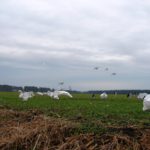
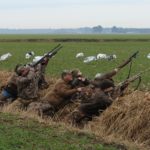
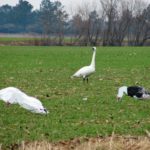
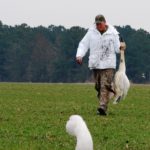
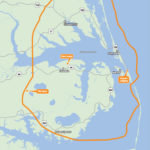



Be the first to comment